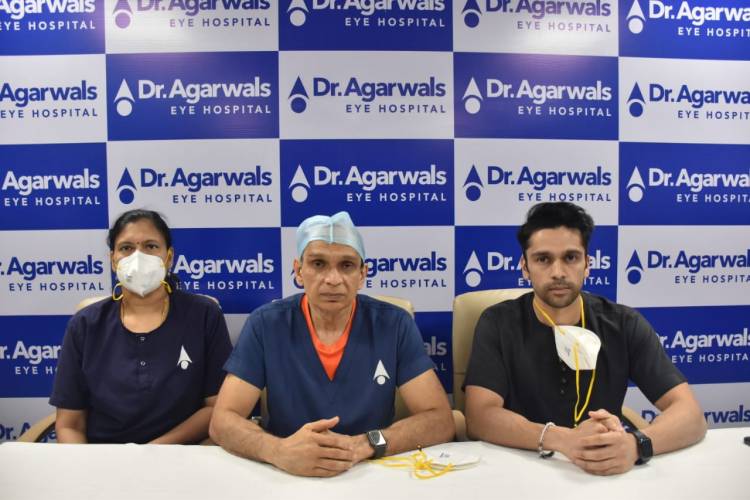Five-fold increase in cases of advanced cataract and dry eyes during pandemic

Five-fold increase in cases of advanced cataract and dry eyes during pandemic
Chennai, 19 February 2021: The pandemic significantly worsened the severity of most eye conditions in people, with an increased number of patients suffering from advanced cataracts, eye infections, severe dry eyes (digital eye strain), and even corneal graft rejection, according to doctors of Dr Agarwal’s Eye Hospital. The worst impact was seen in cases of advanced cataracts and dry eyes, all resulting from delayed treatment or loss of work-life balance due to working from home.
Giving statistics comparing the pre- and post-pandemic situation, Prof. Amar Agarwal, Chairman, Dr Agarwal Group of Eye Hospital, said: “In the last quarter of 2019, less than 10 percent of all cataract patients coming to our hospital were suffering from advanced cataract. In the last quarter of 2020, this figure jumped to 50%, a five-fold increase. The cases of dry eyes due to digital eye strain similarly jumped from 10% to 30-50% over the same period. We noticed worsening of existing cases of glaucoma in many patients as they hesitated to come for regular follow-ups. There were also complications in previous corneal transplant patients such as rejection of cornea and high eye pressure. People with diabetes ignored their period eye check-ups during the pandemic period, leading to severe complications in their retina.”
Dr. Ashvin Agarwal Executive Director, Dr Agarwal’s Group of Eye Hospital highlighted some examples of eye patients suffering from increased morbidity due to delay in seeking treatment. An old person who delayed his cataract surgery after a few months suffered high eye pressure and partial loss of vision. An elderly woman’s poor overall health condition led to bilateral corneal infection and eventual loss of vision in both eyes. A patient with vision only in one eye had a cornea transplant done earlier. He developed an eye infection and could not see an eye doctor due to the lockdown. He is now blind in both eyes and awaiting a repeat cornea transplant. We also saw the case of a young woman who had earlier undergone corneal transplant develop graft rejection and graft failure due to lack of timely eye treatment.
Said Dr. S Soundari, Head of Medical Services, Dr Agarwal’s Eye Hospital: “During the last few months, we have also been seeing a increasing number of people with digital eye strain and dry eyes, which are stemming from excessive use of gadgets and loss of work-life balance. In the early phases of the lockdown, we also saw a few patients with conjunctivitis and others with retinal vascular blockage. They were later confirmed to be corona positive.”
She added: “Patients were worried about contracting coronavirus if they visited the hospital. This fear was very strong in early phases of the pandemic. As a result, the treatment of patients got impacted in a big way. Most people with pre-existing eye problems did not go for regular follow-ups, leading to aggravation of their existing eye problems. Others with new eye problems waited to consult the doctors which led to serious consequences, including loss of vision. Even the patients who took tele-consult wanted all the solutions remotely and there was a strong unwillingness to come to the hospital for physical eye check-up and investigations even when it was deemed necessary.”
Dr. Ashvin Agarwal,: “No health problem is too small that merits neglect in pandemic times. To begin with, tele-consult is a great option and, in many cases, should be enough to get the right advice and treatment. Sometimes the doctor will advise to consult in person. That is the time when not doing anything can aggravate a minor eye problem to a more serious one. Take all precautions with face mask, hand sanitization, social distancing and choose an eye hospital where all safety precautions are being implemented.”
Said Dr. S Soundari, “Diabetic patients above 50 years old need to get their eyes screened at least once a year by an ophthalmologist, as over 30% of these patients end up developing some form of diabetic eye diseases such as diabetic retinopathy, diabetic macular edema, cataract and glaucoma. And about 10% of the patients who are diagnosed with diabetic eye disease get vision threatening diabetic retinopathy. Talking about the examinations, she said that when diabetic patients visit an eye doctor, they may have to undergo examinations such as vision check along with spectacle power, measurement of intraocular pressure, and retinal evaluation. The doctor can suggest blood tests and relevant eye scans. When a diabetic eye disease is diagnosed, investigations like fluorescein fundus angiography, optical coherence tomography and B scan ultrasonography are recommended, depending on the stage of the disease. These scans are essential to stage the disease, plan treatment and monitor the progression of the disease.
Media Contact: Mahesh Kumar / Perfect Relations / 98845 45000

















